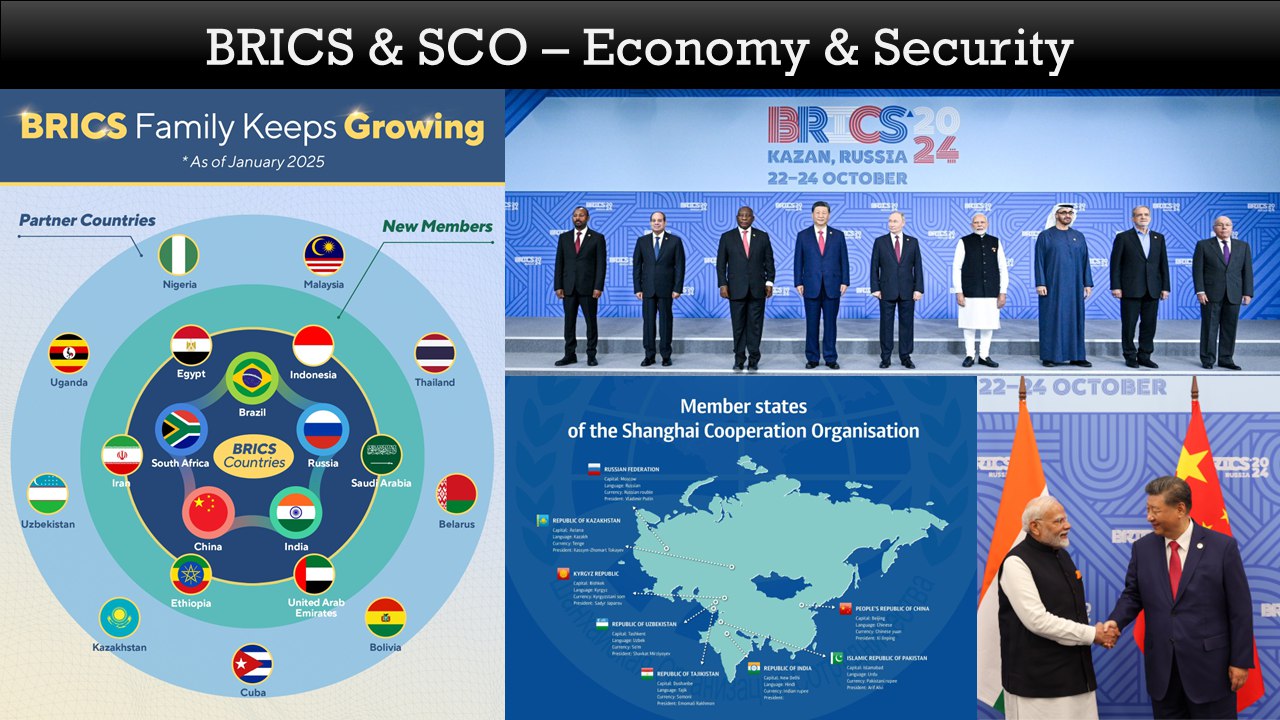The annual summit of the Shanghai Cooperation Organization
(SCO) was held virtually on July 4 with India as the host. Simultaneously South
Africa hosted the Sherpa Meeting of the BRICS (Brazil, Russia, India, China,
South Africa) from July 4-6. Both the meetings had one common factor –
expansion of their respective groupings.
The SCO meeting saw Iran becoming the member and
Belarus set to join in 2024. The BRICS meeting too focused on expansion of
membership beyond the present number of five.
India welcomed Iran’s membership to the SCO focusing
on how it could possibly strengthen the connectivity initiatives such as the
Chabahar Port and the International North-South Transport Corridor (INSTC).
However, India has approached the expansion of BRICS cautiously. A month back
External Affairs Minister Dr. S. Jaishankar termed expansion of BRICS as a work in progress and that India is looking at it with positive intent
and an open mind.
India, as an enthusiastic proponent of multilateral
world order, may justify its participation in the SCO and BRICS, apparently
anti-West forums, as a necessity to engage with different sides. But the way
these forums are shaping up could make India’s maneuvering within them
challenging.
In case of the SCO, India’s stand on two issues
pertaining to national security has placed it on a different side from other
members. First, during the SCO Summit, Indian Prime Minister Narendra Modi
raised the issue of terrorism and how some member countries support terrorists
and terror activities. This was a clear reference to Pakistan’s support to
cross-border terrorism in Jammu and Kashmir, and China shielding terrorists at
international forums such as the United Nations Security Council (UNSC). Second,
in the Joint Declaration of the Council of Heads of State of the SCO, India did
not support China’s Belt and Road Initiative (BRI) as it violates India’s
sovereignty and territorial integrity.
India’s stand is unlikely to find any support from the
SCO members. India initially joined the SCO due to proximity to Russia and to
engage with the Central Asian countries. However, Russia’s influence has waned
and India’s engagements with Central Asian countries, though increased outside
of the SCO, are nowhere near China’s ties with the region. As such India is
left with a limited space to secure its interests in this China-dominated
grouping.
BRICS, with three SCO members – India, China and
Russia, presents a similar picture. There are three issues of concerns for
India within the BRICS. First, as regards to expansion, India is insisting on
establishing well-defined criteria instead of mere recommendations from the existing
members. Second, External Affairs Minister Dr. S. Jaishankar put to rest
speculation about BRICS currency saying that the focus is on strengthening national
currency. This essentially goes against the de-dollarization narrative. Third, most
of the countries seeking membership of BRICS have strong ties with China but
not with India. Some examples are Argentina, Algeria, Cuba, Democratic Republic
of Congo and Guinea-Bissau. Iran, another BRICS aspirant, is a close economic
and strategic partner of China, but has limited engagements with India in the
form of connectivity projects. Some other hopefuls for the BRICS membership
include Saudi Arabia, the UAE and Egypt with which India has close ties which
have been built carefully over the years independent of the BRICS platform. The
possible expansion of the BRICS makes it a China-dominated forum, similar to
the SCO. With Russia’s diminished bargaining power, India remains isolated in
the BRICS.
As much as accepting stakes of various countries in
economic and strategic areas at regional and global level, China’s assertion
has been a driving factor for India to strengthen its engagements with
like-minded countries. While proposing multilateralism and an effective
institutional mechanism responsive to the changing global order India has gone
ahead in the past decade to focus on strengthening its bilateral ties as well.
India’s growing relations with the United States (US),
Japan and Australia resulted in formation of the Quad to address the strategic
and economic challenge posed by China in the Indo-Pacific Region. Security
threat posed by China at the border and in the neighbourhood would always be
India’s priority while engaging at multilateral forums. This makes Western and
democratic countries India’s partners of choice at international level. The
upswing in India’s defence engagements with the US is a testimony to India
putting its national security over balanced multilateral commitments.
Further as a major power in the Indian Ocean Region, India
has diversified its relations with the Middle East, particularly the Gulf
countries, and African countries. The recent plurilateral initiatives involving
the Middle Eastern countries – the I2U2 (India, Israel, the US and the UAE) and
India, Saudi Arabia, the US and the UAE – are aimed at boosting connectivity
between Middle East and South Asia and countering China’s BRI.
Multilateral engagements are important for India.
However, with China’s overbearing presence in the groupings such as the SCO and
the BRICS, India is likely to strengthen its engagements with the forums and
mechanisms countering China. India stands to gain little from the current state
of the SCO and BRICS as these represent two sides of the same coin for India.
(Niranjan
Marjani is a Political Analyst based in Vadodara, India. He
tweets at @NiranjanMarjani)



